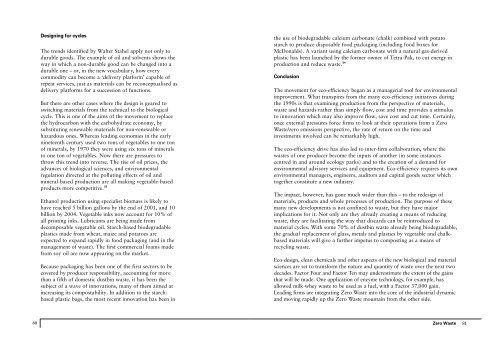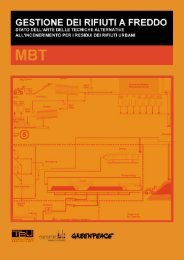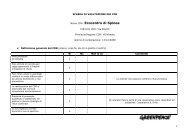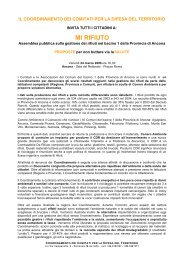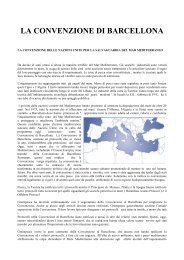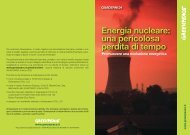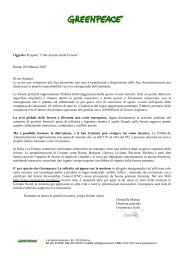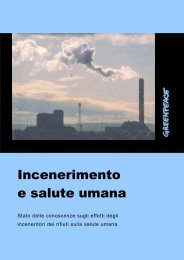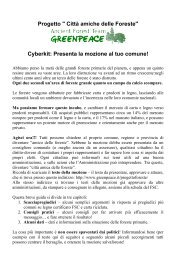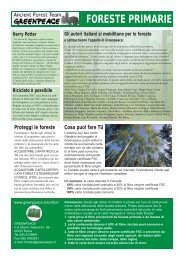Zero Waste by Robin Murray, Greenpeace Environmental Trust 2002
Zero Waste by Robin Murray, Greenpeace Environmental Trust 2002
Zero Waste by Robin Murray, Greenpeace Environmental Trust 2002
You also want an ePaper? Increase the reach of your titles
YUMPU automatically turns print PDFs into web optimized ePapers that Google loves.
Designing for cycles<br />
The trends identified <strong>by</strong> Walter Stahel apply not only to<br />
durable goods. The example of oil and solvents shows the<br />
way in which a non-durable good can be changed into a<br />
durable one – or, in the new vocabulary, how every<br />
commodity can become a ‘delivery platform’ capable of<br />
repeat services, just as materials can be reconceptualised as<br />
delivery platforms for a succession of functions.<br />
But there are other cases where the design is geared to<br />
switching materials from the technical to the biological<br />
cycle. This is one of the aims of the movement to replace<br />
the hydrocarbon with the carbohydrate economy, <strong>by</strong><br />
substituting renewable materials for non-renewable or<br />
hazardous ones. Whereas leading economies in the early<br />
nineteenth century used two tons of vegetables to one ton<br />
of minerals, <strong>by</strong> 1970 they were using six tons of minerals<br />
to one ton of vegetables. Now there are pressures to<br />
throw this trend into reverse. The rise of oil prices, the<br />
advances of biological sciences, and environmental<br />
regulation directed at the polluting effects of oil and<br />
mineral-based production are all making vegetable-based<br />
products more competitive. 53<br />
Ethanol production using specialist biomass is likely to<br />
have reached 5 billion gallons <strong>by</strong> the end of 2001, and 10<br />
billion <strong>by</strong> 2004. Vegetable inks now account for 10% of<br />
all printing inks. Lubricants are being made from<br />
decomposable vegetable oil. Starch-based biodegradable<br />
plastics made from wheat, maize and potatoes are<br />
expected to expand rapidly in food packaging (and in the<br />
management of waste). The first commercial foams made<br />
from soy oil are now appearing on the market.<br />
Because packaging has been one of the first sectors to be<br />
covered <strong>by</strong> producer responsibility, accounting for more<br />
than a fifth of domestic dustbin waste, it has been the<br />
subject of a wave of innovations, many of them aimed at<br />
increasing its compostability. In addition to the starchbased<br />
plastic bags, the most recent innovation has been in<br />
the use of biodegradable calcium carbonate (chalk) combined with potato<br />
starch to produce disposable food packaging (including food boxes for<br />
McDonalds). A variant using calcium carbonate with a natural gas-derived<br />
plastic has been launched <strong>by</strong> the former owner of Tetra-Pak, to cut energy in<br />
production and reduce waste. 54<br />
Conclusion<br />
The movement for eco-efficiency began as a managerial tool for environmental<br />
improvement. What transpires from the many eco-efficiency initiatives during<br />
the 1990s is that examining production from the perspective of materials,<br />
waste and hazards rather than simply flow, cost and time provides a stimulus<br />
to innovation which may also improve flow, save cost and cut time. Certainly,<br />
once external pressures force firms to look at their operations from a <strong>Zero</strong><br />
<strong>Waste</strong>/zero emissions perspective, the rate of return on the time and<br />
investments involved can be remarkably high.<br />
The eco-efficiency drive has also led to inter-firm collaboration, where the<br />
wastes of one producer become the inputs of another (in some instances<br />
centred in and around ecology parks) and to the creation of a demand for<br />
environmental advisory services and equipment. Eco-efficiency requires its own<br />
environmental managers, engineers, auditors and capital goods sector which<br />
together constitute a new industry.<br />
The impact, however, has gone much wider than this – to the redesign of<br />
materials, products and whole processes of production. The purpose of these<br />
many new developments is not confined to waste, but they have major<br />
implications for it. Not only are they already creating a means of reducing<br />
waste, they are facilitating the way that discards can be reintroduced to<br />
material cycles. With some 70% of dustbin waste already being biodegradable,<br />
the gradual replacement of glass, metals and plastics <strong>by</strong> vegetable and chalkbased<br />
materials will give a further impetus to composting as a means of<br />
recycling waste.<br />
Eco-design, clean chemicals and other aspects of the new biological and material<br />
sciences are set to transform the nature and quantity of waste over the next two<br />
decades. Factor Four and Factor Ten may underestimate the extent of the gains<br />
that will be made. One application of enzyme technology, for example, has<br />
allowed milk-whey waste to be used as a fuel, with a Factor 37,000 gain.<br />
Leading firms are integrating <strong>Zero</strong> <strong>Waste</strong> into the core of the industrial dynamic<br />
and moving rapidly up the <strong>Zero</strong> <strong>Waste</strong> mountain from the other side.<br />
80<br />
<strong>Zero</strong> <strong>Waste</strong><br />
81


